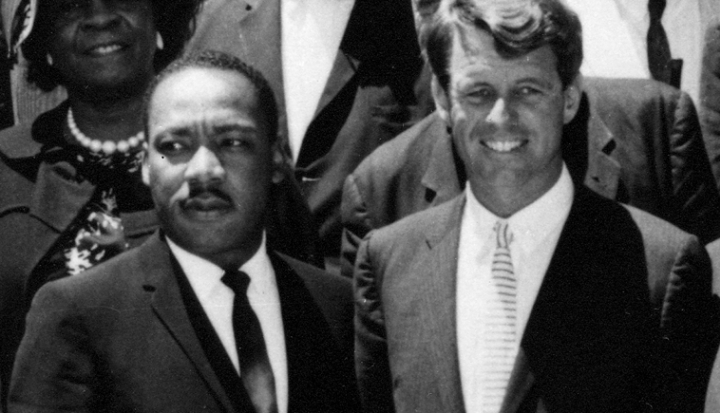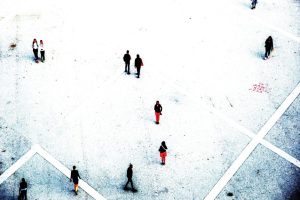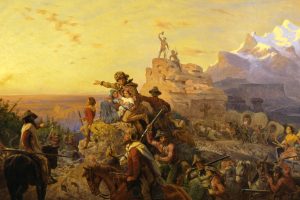On April 4, 1968, Robert Kennedy campaigned for president at Ball State University in Muncie, Indiana. During a question-and-answer forum, a black student addressed the candidate: “Mr. Kennedy, I agree with the programs and proposals that you are making, and I congratulate you on them. But in order for them to work, you’re placing a great deal of faith in white America. My question is: is this faith justified?”
Kennedy replied, “Yes […] I think the vast majority of the American people want to do the decent thing and the right thing.” After the rally, as Kennedy walked to his plane to fly from Muncie to his next stop in Indianapolis, an aid told him Martin Luther King had been shot. When the plane landed in Indianapolis, Kennedy learned definitively that Martin Luther King was dead.
Two months after Robert Kennedy’s assassination on June 5, 1968, pop singer Dion released “Abraham, Martin, and John.” The song imagined the Abraham Lincoln, Martin Luther King, and John F. Kennedy as a civil rights triumvirate waiting in the afterlife to welcome “my old friend Bobby.” The song only reached number four on pop music charts in the United States, though strangely became a number one hit in Canada.
In June 1969, the board of Chicago’s city colleges proposed renaming a campus dedicated to Woodrow Wilson to Kennedy-King College. Speaking in support of the name change, Wilson College president Maceo Bowie declared “All of us—students, faculty, and administration—decided on a name change to symbolize our fight against the evils in our society which caused the deaths of Sen. Robert Kennedy and Rev. Martin Luther King.” The dual memorial, which was also attached to an elementary school in Brooklyn, and many Democratic Party fundraising dinners throughout the United States, obscures an important historical fact: Martin Luther King and Robert F. Kennedy were not friends.
As attorney general, Kennedy authorized an FBI wiretap on King and other civil rights leaders. Ostensibly done in the interest of “national security,” Robert Kennedy wanted a heads-up if anything civil rights leaders were planning would be politically problematic for his brother, the president. The attorney general would be repaid by overhearing King and his circle discuss John F. Kennedy’s assassination with gallows humor and making off-color jokes about the first family.
For his part, King was wary of getting too close to any politician, once stating “you can’t dine the president and represent vigorously black people in America.” At best, the two enjoyed what civil rights activist Andrew Young called a “distant camaraderie.”
But by the last year of their lives both men pushed for a civil rights agenda that tackled the structural and societal roots of racial inequality. Both men would also denounce what they saw as the greatest stumbling block to achieving a more equal and just society: the unceasing loss of life and squandering of resources in Vietnam.
When Kennedy reached Indianapolis, his advisers and local officials wanted him to cancel his campaign stop in an overwhelmingly black neighborhood. He ignored them, brusquely telling the Indianapolis police “if they [the black crowd] would bother you, you’re the one with the problem.” He proceeded to rally at the corner of 17th and Broadway, standing on the back of a flatbed truck and informing the Indianapolis crowd of Martin Luther King’s murder.
News cameras were on Kennedy, so we cannot see the crowd, but their screams are audible in the footage of his speech. He praised King but quickly moved to how the people before him likely felt: “For those of you who are black—considering the evidence evidently is that there were white people who were responsible—can be filled with bitterness, and with hatred, and a desire for revenge. We can move in that direction as a country, in greater polarization—black people amongst blacks, and white amongst whites, filled with hatred toward one another.”
The idea of any public figure, let alone a white U.S. Senator running for president, telling black people that their rage is justified, that they do not have to help heal the nation by being bottomless wells of forgiveness, that this maybe one betrayal too many, is stunning. Kennedy offers anger and withdrawal as legitimate responses to tragedy, and he knows, because he experienced them in the aftermath of his own tragedy: “For those of you who are black and are tempted to fill with—be filled with hatred and mistrust of the injustice of such an act, against all white people, I would only say that I can also feel in my own heart the same kind of feeling. I had a member of my family killed, but he was killed by a white man.”
Still, it was possible that something existed beyond bitterness, mistrust, and hatred. “What we need in the United States is not division; what we need in the United States is not hatred; what we need in the United States is not violence and lawlessness, but is love, and wisdom, and compassion toward one another; and a feeling of justice toward those who still suffer within our country, whether they be white or whether they be black.”
Kennedy warned the turn to justice and compassion was not going to be easy, and the future was uncertain. He even warned that there would likely be more violence to come, but closed with the same hedged hope he offered Ball State student a few hours before, “the vast majority of white people and the vast majority of black people in this country want to live together, want to improve the quality of our life, and want justice for all human beings that abide in our land.”
Kennedy’s words had power and, consequently, Indianapolis escaped the rioting and violence that destroyed large swaths of other American cities in the wake of King’s murder. Today, the entire speech is on a plaque near the intersection where Kennedy spoke. There are also two sculptures cast in high relief, one of Martin Luther King, the other of Robert Kennedy. They are facing each other, each man with an arm outstretched, perhaps reaching to the close the distance that separated them in life. Each man’s shadow is depicted as well, reaching down toward the viewer.
The distance in our camaraderie with these two men is the distance of time, of 50 years. Still, if we choose to act with “compassion toward one another; and a feeling of justice toward those who still suffer within our country, whether they be white or whether they be black,” we can close that distance as well. With their words, with their actions, with the examples of their lives, that is what Martin Luther King and Robert Kennedy call us to do.
Robert Kennedy in Indianapolis, April 4, 1968 from Kennedy King on Vimeo.
Image: Wikimedia Commons














Add comment